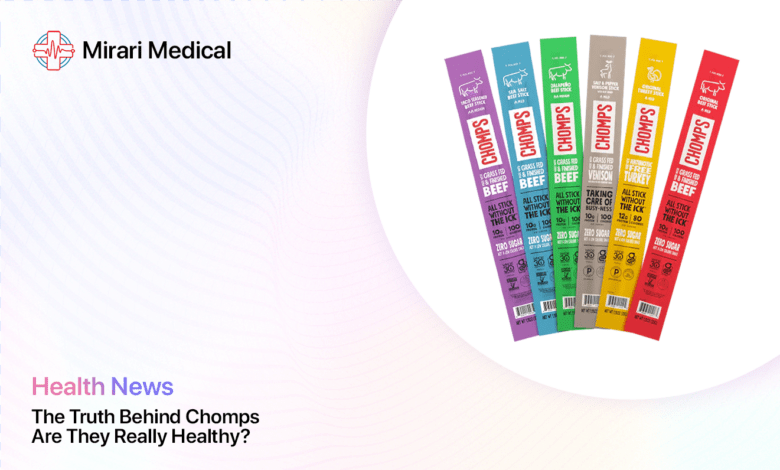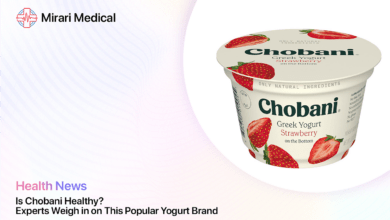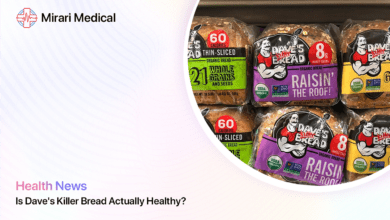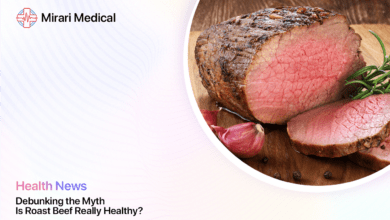The Truth Behind Chomps: Are They Really Healthy?

You may be interested
Did you know that the global meat snacks market is projected to reach a staggering $12.5 billion by 2027?[1] As consumers become more health-conscious, brands like Chomps have emerged, offering a seemingly nutritious twist on the classic beef jerky or meat stick. But with so many claims and conflicting information out there, it can be challenging to separate fact from fiction. In this comprehensive guide, we’ll dive deep into the world of Chomps to uncover the truth about their ingredients, nutritional value, and potential health impacts, helping you make an informed decision about whether these snacks are truly as healthy as they claim.
What Are Chomps?
Chomps is a brand that specializes in producing meat snacks, particularly beef sticks, turkey sticks, and venison sticks. Founded in 2012, the company has gained popularity for its commitment to using high-quality, grass-fed and pasture-raised meats, as well as its avoidance of artificial ingredients and preservatives.
Chomps offers a variety of flavors, including Original Beef, Jalapeño Beef, Sea Salt Beef, Salt & Pepper Venison, Original Turkey, and more. These snacks are marketed as a healthier alternative to traditional beef jerky or meat sticks, boasting a clean ingredient list and a focus on whole, minimally processed foods.
What Are The Ingredients In Chomps?
To truly understand the healthiness of Chomps, it’s essential to examine the ingredients that go into their meat snacks. While the specific ingredients may vary slightly between flavors, here’s a general overview of what you’ll typically find in a Chomps beef stick:
- Grass-fed beef: The primary ingredient in most Chomps beef sticks is grass-fed and grass-finished beef, which means the cattle were raised on a diet of grass and forage, rather than grains or other feed.
- Sea salt: Chomps uses sea salt as a natural preservative and flavor enhancer.
- Celery powder: This ingredient is used as a natural curing agent, providing a source of nitrates that help preserve the meat and enhance its flavor and color.
- Spices and herbs: Depending on the flavor, Chomps may include spices and herbs like black pepper, red pepper, garlic powder, coriander, and others to add depth and complexity to the taste.
- Lactic acid: A naturally occurring acid that helps preserve the meat and enhance its shelf life.
It’s worth noting that Chomps prides itself on using minimal ingredients and avoiding artificial preservatives, colors, flavors, or other additives commonly found in many processed meat products.
Are Chomps Gluten-Free?
Yes, Chomps meat snacks are certified gluten-free, making them a suitable option for those following a gluten-free diet or managing celiac disease or gluten sensitivities.
Are Chomps Keto-Friendly?
Chomps meat snacks are generally considered keto-friendly due to their low carbohydrate content and high protein levels. Most Chomps sticks contain less than 1 gram of carbohydrates per serving, making them a suitable snack option for those following a ketogenic or low-carb diet.
Are Chomps Paleo-Friendly?
Chomps meat snacks are Paleo-certified, meaning they meet the standards of the Paleolithic diet, which emphasizes whole, minimally processed foods and avoids grains, legumes, and other modern agricultural products. The use of grass-fed meats and the absence of artificial ingredients make Chomps a Paleo-friendly snack option.
How Are Chomps Made?
The production process for Chomps meat snacks is designed to preserve the natural flavors and nutrients of the high-quality meats used. Here’s a general overview of how Chomps are made:
- Sourcing: Chomps sources its grass-fed beef and pasture-raised meats from reputable farms and ranches that prioritize sustainable and humane practices.
- Curing: The meats are cured using a combination of sea salt and celery powder, which provides a natural source of nitrates for preservation and flavor enhancement.
- Seasoning: Depending on the flavor, various spices and herbs are added to the meat mixture to create the desired taste profile.
- Stuffing: The seasoned meat mixture is stuffed into natural casings, forming the distinctive stick shape.
- Smoking and drying: The sticks are then smoked and slowly dried to remove moisture, further preserving the meat and enhancing its flavor and texture.
- Packaging: Once fully dried and smoked, the Chomps meat snacks are packaged for distribution and sale.
Throughout the process, Chomps emphasizes minimal processing and the use of natural ingredients, aiming to create a snack that is as close to its whole food form as possible.
What Are The Nutritional Values Of Chomps?
To evaluate the healthiness of Chomps, it’s crucial to examine their nutritional profile. Here’s a breakdown of the typical nutritional values for a single Chomps Original Beef Stick (1.15 oz or 32g):
- Calories: 90
- Total Fat: 6g
- Saturated Fat: 2.5g
- Trans Fat: 0g
- Cholesterol: 25mg
- Sodium: 380mg
- Total Carbohydrates: 0g
- Dietary Fiber: 0g
- Total Sugars: 0g
- Protein: 9g
As you can see, Chomps meat snacks are relatively low in calories and carbohydrates, making them a suitable option for those watching their calorie or carb intake. They are also a good source of protein, with 9 grams per stick, which can help promote feelings of fullness and support muscle maintenance.
However, it’s worth noting that Chomps are relatively high in sodium, with a single stick providing around 16% of the recommended daily intake. They also contain moderate amounts of saturated fat, which should be consumed in moderation as part of a balanced diet.
Are Chomps Really Healthy?
Now that we’ve explored the ingredients, production process, and nutritional values of Chomps, let’s address the burning question: are these meat snacks truly healthy?
What Are The Health Benefits Of Chomps?
Chomps meat snacks offer several potential health benefits:
- High-quality protein source: With 9 grams of protein per stick, Chomps can be a convenient way to boost your protein intake, which is essential for building and repairing tissues, supporting immune function, and promoting feelings of fullness.
- Grass-fed meat benefits: The use of grass-fed and pasture-raised meats in Chomps means they may contain higher levels of beneficial nutrients like omega-3 fatty acids, conjugated linoleic acid (CLA), and antioxidants compared to conventionally raised meats.[2]
- No artificial ingredients: By avoiding artificial preservatives, colors, flavors, and other additives, Chomps may be a better choice for those looking to minimize their exposure to potentially harmful chemicals.
- Convenient and portable: Chomps meat snacks are shelf-stable and easy to take on-the-go, making them a convenient option for busy lifestyles or when healthy snack options are limited.
- Suitable for various dietary preferences: With their gluten-free, keto-friendly, and Paleo-certified status, Chomps can fit into a variety of dietary lifestyles and preferences.
What Are The Potential Risks Of Chomps?
While Chomps may offer some health benefits, there are also potential risks and drawbacks to consider:
- Processed meat concerns: Despite being made with high-quality ingredients, Chomps are still considered a processed meat product. Some research has linked regular consumption of processed meats to an increased risk of certain health conditions, such as heart disease, type 2 diabetes, and certain types of cancer.[3]
- Sodium content: With 380mg of sodium per stick, regular consumption of Chomps could contribute to excessive sodium intake, which can lead to high blood pressure and other health issues.
- Saturated fat content: While the saturated fat content in Chomps is moderate, it’s still important to monitor your overall saturated fat intake, as excessive consumption has been linked to an increased risk of heart disease and other health problems.
- Potential for overconsumption: The convenient and tasty nature of Chomps meat snacks may make it easy to overindulge, leading to excessive calorie and sodium intake if portion sizes are not carefully monitored.
It’s important to remember that no single food is inherently “healthy” or “unhealthy” – it’s the overall dietary pattern and balance that matters most. While Chomps may be a better choice than some highly processed meat snacks, they should still be consumed in moderation as part of a balanced and varied diet.
What Are The Alternatives To Chomps?
If you’re looking for alternatives to Chomps meat snacks, there are several options to consider, both in terms of healthier choices and similar products.
What Are The Healthier Options To Chomps?
Here are some potentially healthier alternatives to Chomps:
- Fresh or dried fruits and nuts: These whole food options can provide a satisfying combination of protein, fiber, and healthy fats, while also offering a variety of vitamins, minerals, and antioxidants.
- Hard-boiled eggs: A simple and portable snack option that provides high-quality protein, along with essential nutrients like vitamin D, choline, and selenium.
- Greek yogurt: A good source of protein, probiotics, and other beneficial nutrients, Greek yogurt can be a satisfying and nutritious snack when paired with fresh fruits or nuts.
- Hummus and vegetable sticks: This combination provides a balance of protein, fiber, and healthy fats, while also offering a variety of vitamins and minerals from the vegetables.
- Edamame or roasted chickpeas: These plant-based options are high in protein and fiber, making them a filling and nutritious snack choice.
While these alternatives may not provide the same meaty flavor and texture as Chomps, they offer a wider range of nutrients and may be a better choice for those looking to prioritize whole, minimally processed foods in their diet.
What Are The Similar Products To Chomps?
If you’re specifically looking for similar meat snack options, here are some alternatives to Chomps:
- Country Archer: This brand offers a variety of grass-fed beef and turkey jerky and meat sticks, with a focus on clean ingredients and no artificial preservatives or sweeteners.
- Epic Provisions: Known for their grass-fed meat bars and bites, Epic Provisions also offers meat sticks made from grass-fed beef, turkey, and other proteins.
- Nick’s Sticks: This brand produces grass-fed beef and turkey meat sticks that are free from antibiotics, hormones, and artificial ingredients.
- Paleovalley: In addition to their popular beef sticks, Paleovalley also offers grass-fed beef and turkey jerky, as well as other Paleo-friendly snacks.
- Tillamook Country Smoker: While not exclusively grass-fed, Tillamook offers a variety of beef and turkey jerky and meat sticks made with high-quality ingredients and no artificial preservatives or sweeteners.
When choosing similar products, it’s important to carefully review the ingredient lists and nutritional information to ensure they align with your dietary preferences and health goals.
What Are The Reviews Of Chomps?
To get a well-rounded perspective on Chomps, it’s helpful to consider reviews and feedback from actual consumers. Here’s a summary of some common themes found in Chomps reviews:
Positive Reviews:
- Many reviewers praise the clean ingredient list and lack of artificial additives in Chomps.
- The grass-fed and pasture-raised meat sources are often cited as a major selling point.
- Reviewers appreciate the variety of flavors available, with the Original Beef, Jalapeño Beef, and Salt & Pepper Venison being popular choices.
- The high protein content and low carb count make Chomps a popular choice for those following ketogenic or low-carb diets.
- Many find Chomps to be a convenient and satisfying snack option, especially when on-the-go or traveling.
Negative Reviews:
- Some reviewers find Chomps to be expensive compared to other meat snack options, especially when purchasing single sticks.
- A few reviewers note that certain flavors, like the Original Turkey, can be somewhat bland or lacking in flavor.
- There are occasional complaints about inconsistent texture or dryness in some Chomps sticks.
- A small number of reviewers report receiving sticks that appear to be past their prime or have an off-putting odor or taste.
Overall, the majority of reviews for Chomps are positive, with consumers praising the brand’s commitment to high-quality ingredients and the variety of flavors available. However, as with any product, there are some negative experiences related to taste preferences, texture, and value for money.
How Can Someone Incorporate Chomps Into Their Diet?
If you’ve decided to incorporate Chomps meat snacks into your diet, here are some tips for doing so in a balanced and mindful way:
- Portion control: While Chomps are relatively low in calories and carbs, it’s still important to practice portion control to avoid overconsumption. Stick to the recommended serving size of one stick per snack.
- Pair with other nutrient-dense foods: To create a more balanced snack, consider pairing Chomps with other nutrient-dense foods like fresh fruits, vegetables, or nuts. This can help provide a wider range of vitamins, minerals, and fiber.
- Hydrate: Due to their high sodium content, it’s important to stay well-hydrated when consuming Chomps or other salty snacks.
- Rotate with other snack options: While Chomps can be a convenient and tasty snack option, it’s important to rotate them with other healthy snacks to ensure you’re getting a variety of nutrients and not relying too heavily on any one food.
- Monitor your overall sodium intake: If you’re watching your sodium intake for health reasons, be mindful of how Chomps and other salty snacks contribute to your daily sodium levels.
- Consider your dietary preferences and goals: If you’re following a specific dietary pattern, such as a ketogenic or Paleo diet, Chomps may be a suitable snack option. However, if you’re trying to prioritize whole, minimally processed foods, you may want to limit your consumption of Chomps and opt for more nutrient-dense snack choices.
Remember, the key to a healthy diet is balance, moderation, and variety. While Chomps can be a convenient and tasty snack option, they should be enjoyed as part of an overall balanced and nutrient-rich eating pattern that includes a variety of whole, minimally processed foods.
Takeaways
- Chomps are a brand of meat snacks, primarily beef sticks, turkey sticks, and venison sticks, made with grass-fed and pasture-raised meats and minimal ingredients.
- They are marketed as a healthier alternative to traditional beef jerky or meat sticks, boasting a clean ingredient list and avoidance of artificial additives.
- Chomps are a good source of protein, relatively low in calories and carbs, and suitable for various dietary preferences like gluten-free, keto-friendly, and Paleo-certified.
- However, they are still considered a processed meat product and are relatively high in sodium and moderate in saturated fat, which should be consumed in moderation.
- Potential health benefits of Chomps include their high-quality protein source, use of grass-fed meats, lack of artificial ingredients, convenience, and suitability for various dietary preferences.
- Potential risks and drawbacks of Chomps include the concerns associated with processed meat consumption, high sodium content, moderate saturated fat levels, and the potential for overconsumption.
- Healthier alternatives to Chomps include fresh or dried fruits and nuts, hard-boiled eggs, Greek yogurt, hummus and vegetable sticks, and plant-based protein sources like edamame or roasted chickpeas.
- Similar products to Chomps include other grass-fed meat snack brands like Country Archer, Epic Provisions, Nick’s Sticks, Paleovalley, and Tillamook Country Smoker.
- Reviews of Chomps are generally positive, with consumers praising the clean ingredients, variety of flavors, and convenience, but some criticisms around pricing, blandness in certain flavors, and occasional quality issues.
- To incorporate Chomps into a healthy diet, practice portion control, pair them with other nutrient-dense foods, stay hydrated, rotate with other snack options, monitor overall sodium intake, and consider your dietary preferences and goals.
- While Chomps can be a convenient and tasty snack option, they should be enjoyed in moderation as part of an overall balanced and varied diet focused on whole, minimally processed foods.
FAQs
Are Chomps suitable for vegetarians or vegans?
No, Chomps are not suitable for vegetarians or vegans as they are made from animal-based proteins like beef, turkey, and venison.
How long do Chomps last?
Chomps have a relatively long shelf life due to their curing and drying process. Unopened packages typically have a best-by date around 1 year from the date of production. Once opened, it’s best to consume Chomps within 2-3 weeks for optimal freshness and quality.
Can Chomps be consumed during pregnancy?
While Chomps are made with high-quality ingredients, it’s generally recommended that pregnant women limit their consumption of processed meats due to potential risks associated with nitrates and other compounds. As with any dietary change during pregnancy, it’s best to consult with a healthcare professional.
Are Chomps a good snack option for children?
Chomps can be a suitable snack option for children in moderation, as they provide a good source of protein. However, their high sodium content may be a concern for some parents, so it’s important to monitor portion sizes and overall sodium intake for children.
Can Chomps be frozen or refrigerated?
Chomps are shelf-stable and do not require refrigeration. However, some consumers prefer to refrigerate or freeze them to extend their shelf life or achieve a different texture. Refrigeration can help maintain freshness, while freezing may make the sticks slightly harder and chewier.
In conclusion, Chomps offer a unique twist on the classic meat snack, providing a high-protein, low-carb option made with high-quality, grass-fed meats and minimal ingredients. While they may be a better choice than some highly processed meat snacks, it’s important to remember that they are still a processed meat product and should be consumed in moderation as part of an overall balanced and varied diet.
By understanding the potential benefits and risks associated with Chomps, as well as exploring alternative snack options, consumers can make informed choices that align with their individual dietary preferences, health goals, and overall commitment to a nutritious lifestyle.
References
- Grand View Research. (2020). Meat Snacks Market Size, Share & Trends Analysis Report By Product (Jerky, Chips, Sausages, Sticks), By Source (Beef, Pork, Poultry), By Region, And Segment Forecasts, 2020 – 2027. https://www.grandviewresearch.com/industry-analysis/meat-snacks-market
- Daley, C. A., Abbott, A., Doyle, P. S., Nader, G. A., & Larson, S. (2010). A review of fatty acid profiles and antioxidant content in grass-fed and grain-fed beef. Nutrition journal, 9, 10. https://doi.org/10.1186/1475-2891-9-10
- Micha, R., Wallace, S. K., & Mozaffarian, D. (2010). Red and processed meat consumption and risk of incident coronary heart disease, stroke, and diabetes mellitus: a systematic review and meta-analysis. Circulation, 121(21), 2271–2283. https://doi.org/10.1161/CIRCULATIONAHA.109.924977
Your trusted source for health info, offering expert advice, news, and tips to stay healthy and informed.





